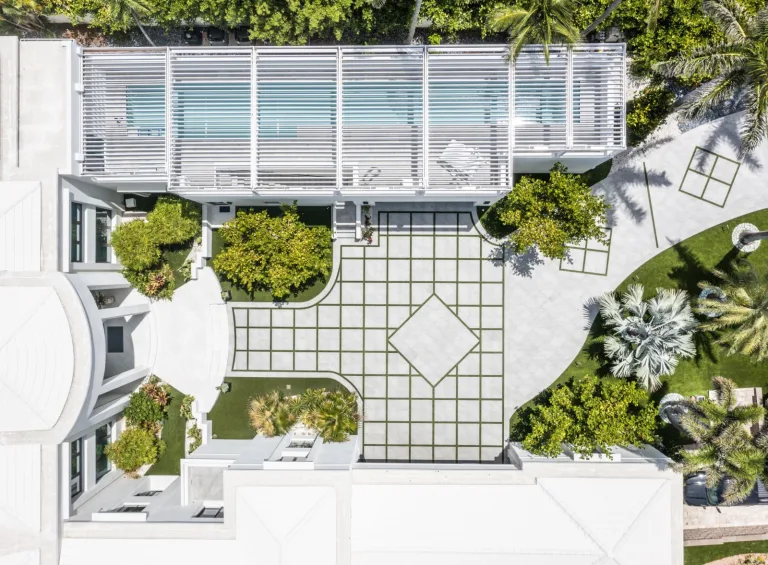How much slope should a pergola roof have to drain? A well-designed roof prevents water pooling, which can lead to structural damage. A pergola roof with the right slope ensures proper drainage and enhances durability. Without it, rainwater can accumulate, causing leaks or material deterioration over time.
Different materials—such as polycarbonate, aluminum, and glass—affect how a roof manages water flow. Each type requires specific angles to prevent water buildup. Understanding these factors will help homeowners and designers create a functional and long-lasting outdoor space.
Table of Contents
Why is Roof Slope Important for a Pergola?
A pergola’s roof slope plays a key role in its functionality and longevity. It helps direct water away from the structure, preventing leaks, damage, and costly maintenance. A well-planned slope also enhances the pergola’s durability and contributes to a comfortable outdoor environment.
Preventing Water Accumulation
A flat pergola roof without a slope can trap water, leading to long-term issues like leaks and structural damage. Over time, standing water can cause materials to deteriorate, making maintenance costly.
An angled pergola design ensures efficient roof drainage. With the right slope, rainwater flows toward gutters or drainage points, preventing unwanted water accumulation. Azenco Outdoor pergolas feature an integrated gutter system, which directs water away from the structure. This system not only prevents damage but also makes the pergola low maintenance.
Enhancing Durability and Lifespan
Adding a minimum slope to a pergola roof extends its lifespan by protecting materials from wear. A well-pitched roof prevents issues like mold, rust, and UV degradation. For example, aluminum pergolas are resistant to rust, but prolonged exposure to standing water can still lead to material degradation. Polycarbonate sheets, on the other hand, may weaken if water is not directed properly.
Azenco Outdoor pergolas feature an integrated water drainage system, which ensures that water flows efficiently off the structure. This system makes maintenance easier and prevents potential damage, allowing homeowners to enjoy a low-maintenance and long-lasting outdoor solution.
Ensuring Aesthetic and Functional Outdoor Space
A sloped pergola roof not only enhances drainage but also improves outdoor aesthetics. The slope can affect light penetration, airflow, and shading, creating a more comfortable environment.
A well-planned pergola slope helps balance sunlight exposure and ventilation while maintaining a clean look. Choosing the right roof angle ensures both functionality and visual appeal, making the pergola a seamless part of the outdoor living area.
Recommended Slope for Different Pergola Roof Types
Each type of pergola roofing material requires a specific slope for optimal drainage. The right slope prevents water buildup and ensures the structure remains sturdy and long-lasting. Whether choosing a flat or angled design, understanding the recommended slope is essential.
Flat Roof Pergolas – Is a Slope Necessary?
Many assume that flat roof pergolas do not need a slope, but that’s incorrect. Even a flat design requires a minimum slope of 5-10 degrees to direct water runoff efficiently. Without it, water can pool, leading to long-term damage and frequent repairs.

Polycarbonate Roofing and Its Ideal Slope
Polycarbonate sheets are popular for pergola roofs due to their lightweight and durable nature. However, they require at least a 5-degree slope for effective drainage. This ensures rainwater runs off smoothly instead of collecting on the surface.
Additionally, transparent and tinted polycarbonate sheets may have different drainage efficiencies. Tinted sheets reduce glare and heat absorption but require careful slope planning to maintain proper water flow.
Aluminum Roof Pergolas – Best Slope for Water Flow
Aluminum pergola roofs require at least 1/16” of slope per foot to prevent water accumulation. Without a sufficient slope, standing water can cause corrosion and leaks.
An angled roof pergola with an aluminum roof is ideal for areas with heavy rainfall. The steeper the angle, the faster water drains, reducing maintenance and extending the lifespan of the structure.
Sloped vs. Flat Roof Pergolas – Which One is Better?
Both sloped and flat roof pergolas have their advantages. An angled roof enhances drainage and durability, making it ideal for wetter climates. In contrast, a flat roof pergola offers a modern, sleek look, but it must include a proper drainage system.
Azenco Outdoor pergolas are not flat roofs; instead, the slope is carefully calculated based on the pergola dimensions. The integrated gutter system ensures effective drainage, maintaining durability and structural integrity over time. This makes modern pergolas both aesthetic and functional, regardless of slope choice.
Factors Affecting the Ideal Slope
The right pergola roof slope depends on various factors, including climate, roofing material, and structural design. These elements influence how water drains from the roof and affect the pergola’s overall durability. By considering these factors, homeowners can ensure a functional and aesthetically pleasing pergola.
Climate and Rainfall
The ideal roof pergola slope depends on climate. Areas with heavy rainfall require a higher roof angle to prevent water buildup. In contrast, drier regions can have a lower minimum slope, as water drainage is less of a concern.
Roofing Material Considerations
Different roofing materials require specific slopes. For example, lightweight polycarbonate sheets need a steeper angle than aluminum roofing to prevent sagging. Choosing the right slope based on material ensures long-term performance and minimal maintenance.
Structural Support and Design Aesthetics
The pergola’s frame, support beams, and design influence the required slope. A balance between structural integrity and aesthetics ensures the pergola functions well while enhancing the outdoor space.
Modern pergolas can be customized for both visual appeal and drainage efficiency, ensuring they complement the surrounding architecture.
How to Calculate and Implement the Right Slope?
Determining the correct slope is crucial for effective water drainage and long-term structural integrity. By using the proper formula and best installation practices, homeowners can ensure their pergola roof effectively directs rainwater away, reducing maintenance and potential damage.
Determining the Correct Roof Angle for a Pergola
A simple formula helps calculate roof slope:
Slope = 1/16” to 1/8” per linear foot toward drainage points.
For example, if a pergola is 10 feet long, the slope should be between 5/8” and 1-1/4” to ensure proper water runoff.
Installation Tips for Slope Pergolas
Proper installation ensures effective roof drainage. Key factors include:
- Drainage direction: Water should flow toward designated runoff points.
- Gutter placement: Integrated gutters enhance water management.
- Support beams: Structural reinforcement maintains stability and durability.
Common Mistakes to Avoid
Avoid these common installation errors:
- Insufficient roof angle, leading to water pooling.
- Incorrect roofing material selection, affecting durability.
- Poor drainage planning, causing leaks and structural issues.
Conclusion
A well-designed pergola roof slope ensures efficient drainage, durability, and visual appeal. The recommended minimum slope depends on the material and climate conditions.
For flat roof pergolas, a 5–10-degree slope prevents water accumulation. Aluminum and polycarbonate roofs require specific angles for efficient drainage.
Azenco Outdoor’s integrated gutter system allows homeowners to customize their pergolas without worrying about drainage. Our certified dealers and engineering team will ensure the ideal slope and drainage solution, making the process seamless and stress-free. When planning an outdoor space, factors like slope, roofing material, and climate all contribute to creating a long-lasting, functional pergola.



2 Responses
Choosing the right roofing contractor mesa means getting top-quality service tailored to your roofing needs. From inspections to replacements, professional roofers provide solutions that enhance curb appeal, increase efficiency, and prevent costly future repairs.
Yes, we agree! It is a crucial step when designing and building your pergola.